The FCA, 1946–2005
Published in 20th-century / Contemporary History, Features, Issue 4 (July/August 2011), Volume 19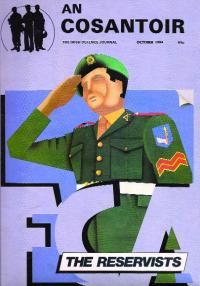
The front cover of a special issue (October 1984) of An Cosantoir, the Irish defence journal, dedicated to the FCA. (Sgt. E. Staunton)
The Forsa Cosanta Aitiuil came into being on 6 February 1946 with the demise of its predecessor, the Local Defence Force (LDF). The LDF had been formed in 1941 as a part-time force to support the Permanent Defence Force (PDF), the regular army and air corps, and in 1943 numbered over 100,000. Although the LDF existed under an ambiguous ‘semi-military’ status, particularly regarding ranks, battalions were organised in cities, for example the 47th and 48th Battalions in Cork, and a few specialist units were also established. Although there was some continuity with the old LDF (the urban battalions were retained, for example), the FCA was part of the Defence Forces proper, using the same ranks and unit structures. Recruits swore an oath of allegiance and officers received the president’s commission. Not all FCA battalions originated with the LDF. The Pearse Battalion, drawn from Dublin’s universities, had originated as the Regiment of Pearse of the Volunteer Force in 1935, while the 26th Battalion was originally a unit of the army’s second-line reserve, raised in 1940, from 1916–21 veterans. The 26th Battalion eventually numbered 1,000, some 90 of whom stayed on after its transfer to the FCA, with the balance made up of veterans’ sons.
Joining ‘for the boots’
Problems soon manifested themselves that would plague the FCA throughout its existence, primarily the ‘establishment’ strength against actual strength. Given the LDF’s success, an FCA establishment of 60,000 was not thought unrealistic. Thiswould mainly consist of 99 infantry battalions, three artillery regiments and smaller support units such as engineering and signals. FCA battalions were commanded entirely by FCA officers, with some military expertise provided by Old IRA andLDF veterans. The actual strength of the FCA at its inception was 37,323, the highest point for the force, from which it would continually decline.
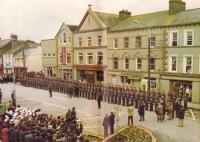
An FCA guard of honour for President Hillary, Dunmanway, June 1983—a regular duty for FCA members. (An Cosantoir)
Another problem was summed up by one FCA officer, who noted:
‘Some people joined “for the boots”, and having received same were not seen again, while others found out after some time in uniform that drilling and discipline generally were not to their liking. These latter categories, classified as “non-effectives”, were struck off the records subsequently as being “of no further use to the service”.’
The avoidance of a ‘non-effective’ classification required only an accumulated 48 hours of annual attendance at evening parades and weekend camps. There was no doubting the commitment of the FCA’s more enthusiastic members, who thought nothing of walking or cyclinglong distances over dark country roads to attend training sessions. Many were denied even a buildingto train in by public apathy.
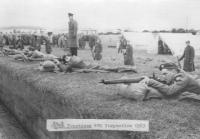
Range practice (in 1963) with the bolt-action Lee-Enfield rifle—the standard FCA weapon for most of its existence.
During the Emergency, grateful local communities had provided the LDF with schools and community halls in which to train—facilities withdrawn in many cases after 1945. Thereafter some FCA units were obliged to meet at rain-soaked crossroads and roadsides. Of the 400 men of the Abbeyleix Battalion, it was estimated that a third had no building for training, although one unit obtained a bank loan to buy themselves a Nissen hut. In Meath public apathy towards the FCA bordered on hostility, with Navan (population over 4,000) boasting an FCA membership of less than ten.
Each FCA man was issued with a bolt-action Lee-Enfield rifle (in rural units it was standard practice to keep the rifle at home, as with many other European reserve forces). The uniform was the same coarse ‘bullswool’ pattern issued to the regular army, including sturdy hobnailed boots and a popular heavy greatcoat. These were issued every three years, the same uniform being used for both tactical training and for parades.
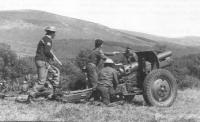
An FCA artillery crew in the Glen of Imaal—their 4.5in. howitzer dates from the First World War.
To an extent the FCA was something of a social movement, enabling young Irishmen to make friends from greatly different backgrounds and to learn useful skills such as first aid and automotive skills. Most acquired discipline and self-confidence, while some were able to avail of leadership training. The FCA provided an outlet for many unemployed people who were able to devote their talents and energies to a public body. In its early days the force enjoyed a high public profile, participating in annual parades on Easter Monday and St Patrick’s Day, and providing frequent guards of honour for dignitaries.
Summer training camps
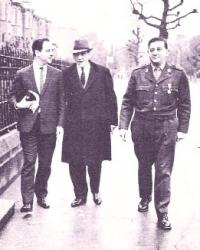
Captain (later Commandant) Joseph Briscoe (in uniform)—of the famous Dublin Jewish/Fianna Fáil family, with brother Ben (left) and father Robert (centre)—joined the FCA in 1946 and retired 50 years later, making him its longest-serving member.
Shortly after its inception, the FCA introduced an annual summer training camp of two weeks’ duration. Few employers were willing to release men for this period and most had to sacrifice holiday time to attend. To compensate, the training camps were thoughtfully sited in such convivial locations as Lahinch and Youghal and a bounty was authorised for attendees. This amounted to over £6, a princely sum in 1950 but a pittance by the 1970s, when it was next increased. Winter camps were also authorised to facilitate seasonal workers such as farmers and fishermen who were unable to attend a camp in the summer. It soon became apparent that FCAstandards varied widely, particularly within rural battalions dispersed over wide areas of countryside. Few battalions exceeded 250 men and most could not meet the minimum figure of 150. The high turnover of personnel prevented units from carrying out more than basic military training, often resulting in a perception that training should be confined to parade drill and weapons skills. Yet a few FCA units attained spectacular standards, particularly ‘A’ Company of the 26th Battalion, which carried out a gruelling 25-mile march across the Wicklow Mountains in 1949. The 26th Battalion maintained a healthy rivalry with the Pearse Battalion and the 11th Cavalry Regiment. Apart from the universities, the Pearse Battalion also raised units in such élite schools as Belvedere and Clongowes, and even adopted a crest recognised by the Genealogical Office. (A Pearse Battalion Association still exists today.)
In late 1948 the 11th Cavalry Regiment was activated in Dublin, the only armoured unit of its size in the FCA or PDF. A squadron was raised from students at Bolton Street College of Technology. The new regiment was equipped with Ford Mark VI armoured cars, which had been ‘up on blocks’ since 1945, and the new regiment was justly proud of attaining a standard high enough to deploy in its entirety to Galway the following summer.
Integration and rationalisation
In 1950 the FCA’s effective strength was 25,776, declining to 21,784 in 1951. This was a symptom of heavy emigration, which devastated the rural battalions. The Old IRA veterans retired but a family tradition was evolving, with sons following their fathers’ service. Bren and Vickers machine-guns were introduced in 1957, and in 1959 a radical overhaul for the FCA was announced. Defence planners had recommended the amalgamation of the PDF and FCA, and that year ‘integration’ was formally launched. This envisaged six infantry brigades, each a mix of FCA and PDF, with the reserve the larger component. Almost all FCA units would have a PDF cadre and commanding officer.
Heavy rationalisation of the FCA (now numbering under 20,000) was inevitable. Most of the 99 infantry battalions possessed under 100 men and were redesignated as companies in seventeen new battalions. A few battalions had numbered over 400 men, such as the Pearse Battalion, which was understandably aggrieved to find itself redesignated ‘D (Pearse) Company, 20th Battalion’. Very few pre-1959 units survived integration. An exception was the 11th Cavalry Regiment, which, although redesignated the 11th Motor Squadron, retained its Pegasus insignia.
The FCA accessed some new resources: for example, the 1962 manoeuvres near Baldonnel involved ‘attacks’ by Air Corps Vampire jets. Nevertheless, any hopes that the FCA would receive modern equipment were to prove unfounded. Although the PDF, itself starved of resources, obtained modern FN assault rifles, support weapons and special combat uniforms, the FCA would soldier on with bullswool uniforms and Lee-Enfield rifles for many more years. The three FCA motor squadrons were equipped with 1940s vintage Ford and Beaverette armoured cars, while the three FCA artillery regiments’ armament included pre-1914 75mm guns (retired in 1968) and four civil war 18-pounders (retired in 1976).
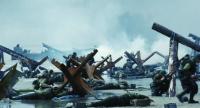
Their finest hour? The FCA won plaudits by providing disciplined extras for such film productions as Braveheart and Saving Private Ryan. The D-Day landing scenes for the latter were filmed over the summer of 1997 on Ballinesker beach, just east of Curracloe, Co. Wexford. (Paramount Pictures)
Internal security duties after 1969
Old problems continued to plague the FCA, particularly a high turnover of personnel and low training standards, which resulted in few FCA units (with some notable exceptions) attaining PDF standards of efficiency. This resulted in heavy strain on the PDF, which was further stretched to breaking point by internal security duties after the eruption of violence in Northern Ireland in 1969. Whatever the faults of the FCA at unit level, the force fully justified its existence at this time by providing a pool of reservists for static duties in barracks and vital installations, freeing up regular troops for other duties. The new situation required a new system of security screening for FCA personnel and the end of an old tradition: from 1970 FCA rifles were no longer kept at home, being stored in PDF barracks instead. This required many rural units to use dummy rifles and restricted training to increasingly dull and repetitive routines.
In 1977 one foreign military journal noted of the FCA that ‘its arms and equipment are a living military museum’. The Lee-Enfield rifle was now decidedly obsolete, although the Bren remained a respectable weapon. The FCA (and PDF) artillery was now equipped with 25-pounders and 120mm heavy mortars. By 1979 it was obvious that ‘integration’ was a failure. Jane’s, the influential military journal, noted that ‘from 1959 to 1979 the regular Army was further diluted by theoretical integration with the part-time territorial defence force to provide six largely mythical brigades’. Integration was abandoned and FCA units became separate entities.
The 1980s recession involved more cost-cutting for the FCA. Annual training camps were reduced to one week, causing a further decline in training standards. The annual gratuity (now worth between £154 and £371) was subject to income tax. Heavy emigration again took a toll of younger members: in 1986 the establishment strength was set at 22,214, although the actual strength was 14,848. The hated ‘bullswool’ was finally replaced with a smart new parade uniform, which was useless for outdoor training: FCA members were obliged to provide their own combat uniform, although this was technically prohibited by regulations.
The FCA still represented a wide cross-section of society, which was further increased by the admission of female recruits in 1990. That year the obsolete Lee-Enfields were replaced with obsolescent FN rifles and combat uniforms were issued, allowing greater emphasis on such skills as tactics and patrolling. The FCA won plaudits by providing disciplined extras for such film productions as Braveheart and Saving Private Ryan.
Disestablishment
The Celtic Tiger years were not good for the FCA. Although the two-week camp was reintroduced, many people were more inclined to spend increasingly precious holiday time in more exotic locations than the Curragh or the Glen of Imaal. Neither did the FCA gratuity compare well to income available elsewhere. By 1996, the FCA’s 50th anniversary, the force’s notional strength was 12,500, with effective strength under 8,500. In 1997 a special study of the FCA found several weaknesses, notably high turnover of personnel and problems with PDF cadres. Another concern was ‘varying’ standards of physical fitness among FCA members, a consequence of the increasingly sedentary modern lifestyle. These findings resulted in the launching of an entirely new Reserve Defence Force (RDF) in October 2005 and the final disestablishment of the FCA and all of its units. Although the new RDF had an establishment of 11,000, the 2009 figures gave an effective strength of only 6,000. It is striking that at a time when the state possesses its greatest potential pool of citizen soldiers (greatly increased by the admission of females) the current RDF numbers less than a sixth of the 1946 FCA. HI
Terence O’Reilly is the author of Hitler’s Irishmen (Mercier Press, 2008) and Rebel heart. George Lennon: Flying Column commander (Mercier Press, 2009).
Further reading:
An Cosantoir (Irish Defence Journal), 1946–2005.
J. Hegarty, Bullswool battalions (Cork, 1985).
L. O’Brien, A history of the Pearse Battalion 1946–1959 (Dublin, 2005).
















